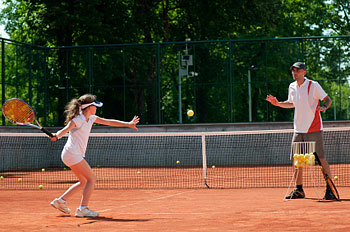NOVEMBER, 2011:
WHY COACHING?
Because athletes – amateur and professional alike – in all sports, particularly the individual ones, often misperceive their performance, both the failures and the successes. Nothing new there. Worse yet, they can be in denial and, amazingly, simultaneously without viable solutions.
In his recent book, Perplexities of Consciousness, Eric Schwitzgebal contends that our powers of introspection are not always an accurate recounting of events, and that in reality our conscious experience of being on the inside is often confused and contradictory. Just ask both doubles teams to reconstruct the points regarding the correct game score – 40-30 or 30-40 for example. And that’s just regarding the score line, never mind the mechanical nuances, or lack thereof, of that inside-out forehand you have trouble with.
 But in club tennis, where everyone prefers the winning experience to the losing one, most go it alone without even periodic coaching or tune-ups. The resulting underachievement of their potential for better performances – the ability to more consistently make one’s existing good shots and reduce the occurrences of one’s bad shots - along with the burden of not really understanding the reasons for an off-day, or a prolonged slump where they’re “plateauing,” is extremely limiting.
But in club tennis, where everyone prefers the winning experience to the losing one, most go it alone without even periodic coaching or tune-ups. The resulting underachievement of their potential for better performances – the ability to more consistently make one’s existing good shots and reduce the occurrences of one’s bad shots - along with the burden of not really understanding the reasons for an off-day, or a prolonged slump where they’re “plateauing,” is extremely limiting.
Running Coach Terence Mahon believes that the biggest challenge of self-coaching is honestly evaluating how you’re really doing. He said, “Athletes are used to looking at one day. But if you look at one day of training [playing], you are not seeing the whole map. Coaches are working off of the experience not only of that athlete but of many before them.” And over many years.
It’s a rarity on the professional tennis tour when an accomplished player is without a coach. But Jo-Wilfried Tsonga is doing just that lately. He parted ways with his coach in the middle of the 2011 campaign, and has enjoyed a resurgence in the season’s second half which has afforded him an excellent chance to qualify for the final 8 showdown in London later this month. An acrobatic, athletic player, it’s believed that he made the change because he felt too reigned-in and “cookie-cuttered.” That can happen in clubland as well, facilitated by well intentioned but one-way-is-the-only-way coaches.
In the end it’s paramount that club pros challenge – if retained - player’s erroneous self-evaluations on why they are struggling, for example, with their high backhand mechanics or second serve mind set. Simultaneously, players with eons less experience and game knowledge must be open minded, avoid defensiveness and being argumentative, and realize that the coach is with them, not against them. If it’s not a good player-coach fit, then either party should take initiative and suggest a new direction with no hard feelings.
By the way, if the pro-coach is inept at proficiently demonstrating any aspect of ball striking mechanics, or unable to impart the mental-emotional nuances of the game, that’s another red flag indicating it’s time to move on.
But the coach also has a huge responsibility to not cross the line: interfere with a player’s natural, inner athletic approach to the game, their brain hard wiring, and the percentage breakdown of how they best receive instruction – visually (seeing it), auditorily (hearing it), kinesthetically (feeling it).
At the end of the day it still takes two to tango.
Questions and comments are welcome at anytime for all tips present and past via email.
This Tip of the Month is copyright© by Jak Beardsworth Tennis. All rights reserved. Copies may be made only with the permission of and by Jak Beardsworth. Contact him here.
Tips Archive
- May, June, 2013 JUST TALKING HEADS OR MORE [read more]
- March, April, 2013 SELF-TALK: Good, Bad, or Indifferent [read more]
- January, February, 2013 BOOK-A-MILLION: Do Tennis Players Read? [read more]
- December, 2012 THE KEY TO TOUR LEVEL BALL STRIKING: And How to Learn It [read more]
- November, 2012 ARE YOU A THUDDER, A TWANGER, OR A PINGER: Racket Dampeners [read more]
- September, October, 2012 SMART SHOTS [read more]
- July, August, 2012 TEN TOP STRESS REDUCERS [read more]
- June, 2012 MAKING YOUR LESSONS STICK [read more]
- May, 2012 THE IMPOSSIBLE: Accelerating and Decelerating Simultaneously [read more]
- April, 2012 PLAYER DISCONNECTION [read more]
- March, 2012 BENDING THE SERVE IN [read more]
- February, 2012 UNDERSTANDING TERMINOLOGY: Drill vs Clinic vs Team Practice [read more]
- January, 2012 PLAYING SCARED? [read more]
- December, 2011 CUTTING OFF THE ANGLE…VERTICALLY [read more]
- November, 2011 WHY COACHING? [read more]
- October, 2011 THE EASY BALLS ARE NOT EASY [read more]
- August/September, 2011 NEVER TOO LATE FOR OLDER DOGS [read more]
- June/July, 2011 HARD COURTS, SOFT COURTS, and YOUR BODY'S ADAPTATION [read more]
- April/May, 2011 JAW DROPPNG [read more]
- March, 2011 CLUB DOUBLES' INCREASINGLY MISSING LINK [read more]
- February, 2011 TIP 2 | POOH POOHING DOUBLES STRATEGY SESSIONS [read more]
- February, 2011 TIP 1 | CLAY TO HARD, HARD TO CLAY [read more]
- January, 2011 ICING THE SERVER WHEN RECEIVING IN THE BIG MOMENTS [read more]
- December, 2010 JOHN ISNER’S “GOOD MISS” [read more]
- November, 2010 THE MOST NEGLECTED SHOT IN THE GAME [read more]
- October, 2010 BALL BOUNCING and the SERVE [read more]
- September, 2010 TAKE YOUR EYE OFF THE BALL [read more]
- July-August, 2010 SUMMER SCHOOL COURTSIDE CRIB SHEET [read more]
- May-June, 2010 THE 2-HANDED JUMP BACKHAND: The Dumbest Shot in Tennis [read more]
- April, 2010 THE STANDING AROUND SYNDROME [read more]
- March, 2010 THE ELUSIVE SERVICE TOSS [read more]
- February, 2010 PREPARING TO START THE POINT: Serving and Receiving [read more]
- January, 2010 DEBUNKING THE MODERN GAME [read more]
- December, 2009 RELAX – IT'S JUST A RALLY BALL [read more]
- November, 2009 DEFEATING THE POACHER [read more]
- October, 2009 PRACTICE, PRACTICE, PRACTICE [read more]
- September, 2009 SERVING SUCCESS: Warming-Up vs Match Play [read more]
- August, 2009 THE SPLIT STEP: Defending the Court, Rushing the Net, and More [read more]
- July, 2009 THE THIRD GROUNDSTROKE [read more]
- June, 2009 HOW MANY HANDS DOES IT TAKE? [read more]
- May, 2009 THE MOST IMPORTANT SKILL [read more]
- April, 2009 PLAYING IN THE FLORIDA WIND [read more]
- March, 2009 Letting them Play for Peak Performance in Clubland [read more]
- February, 2009 SUPPORTING YOUR GAME [read more]
- January, 2009 RESPECTING THE GAME: Top 10 Do's & Don'ts [read more]
- December, 2008 Getting the Warm-up Right [read more]
- November, 2008 Visualize...Realize: The Mind Body Connection [read more]
- October, 2008 Reading Their Mail [read more]


